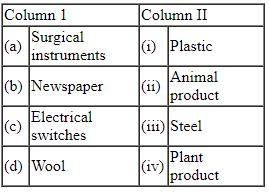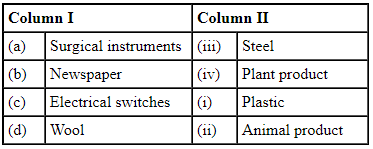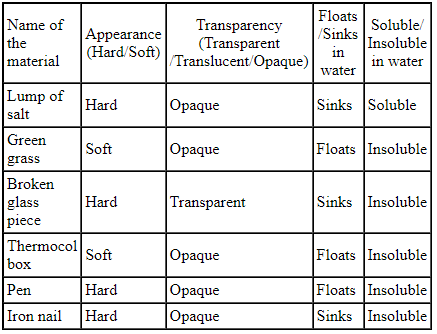NCERT Exemplar Solutions: Sorting Materials into Groups | Science for Class 6 PDF Download
Multiple Choice Questions
Q1: An iron nail is kept in each of the following liquids. In which case would it lose its shine and appear dull?
(a) Mustard oil
(b) Soft drink
(c) Coconut oil
(d) Kerosene
 View Answer
View Answer 
Ans: (b)
Soft drinks contain water, carbon dioxide and acid due to which iron nail is corroded and appears dull.
 Corrosion of iron nail
Corrosion of iron nail
Q2: Pick one material from the following which is completely soluble in water.
(a) Chalk powder
(b) Tea leaves
(c) Glucose
(d) Sawdust
 View Answer
View Answer 
Ans: (c)
Glucose is one substance which is completely soluble in water.
Q3: You are provided with the following materials
(i) magnifying glass
(ii) mirror
(iii) stainless steel plate
(iv) glass tumbler.
Which of the above materials will you identify as transparent?
(a) (i) and (ii)
(b) (i) and (iii)
(c) (i) and (iv)
(d) (iii) and (iv)
 View Answer
View Answer 
Magnifying glass and glass tumbler are transparent materials.
Q4: Boojho found a bag containing the following materials
(i) Mirror
(ii) Paper stained with oil
(iii) Magnet
(iv) Glass spectacles
Help Boojho in finding out the material(s) which is/are opaque.
(a) (i) only
(b) (iv) only
(c) (i) and (iii)
(d) (ii) and (iv)
 View Answer
View Answer 
Ans: (c)
Mirror is opaque since it is painted on one side.
Magnet is opaque since it is made up of iron metal.
Q5: While doing an activity in class, the teacher asked Paheli to handover a translucent material. Which among the following materials will Paheli pick and give her teacher?
(a) Glass tumbler
(b) Mirror
(c) Muslin cloth
(d) Aluminium foil
 View Answer
View Answer 
Ans: (c)
Muslin cloth is translucent since we can see through it but not clearly.
Glass tumbler is transparent.
Mirror and aluminum foil are opaque.
Q6: Which pair of substances among the following would float in a tumbler half-filled with water?
(a) Cotton thread, thermocol
(b) Feather, plastic ball
(c) Pin, oil drops
(d) Rubber band, coin
 View Answer
View Answer 
Ans: (b)
Feather and plastic ball will float on water since they are lighter than water.
Q7: Which among the following are commonly used for making a safety pin?
(a) Wood and glass
(b) Plastic and glass
(c) Leather and plastic
(d) Steel and plastic
 View Answer
View Answer 
Ans: (d)
Steel can be moulded to get sharp points and plastic is used to seal the edges. Hence steel and plastic are used for making safety pins.
Q8: Which of the following materials is not lustrous?
(a) Gold
(b) Silver
(c) Wood
(d) Diamond
 View Answer
View Answer 
Ans: (c)
Wood is not lustrous since it is not a crystalline substance.
Q9: Which of the following statements is not true?
(a) Materials are grouped for convenience.
(b) Materials are grouped to study their properties.
(c) Materials are grouped for fun.
(d) Materials are grouped according to their uses.
 View Answer
View Answer 
Ans: (c)
Materials are usually grouped to study their properties and according to their uses in systematic manner. Hence materials are not grouped for fun.
Q10: Find the odd one out from the following.
(a) Tawa
(b) Spade
(c) Pressure cooker
(d) Eraser
 View Answer
View Answer 
Ans: (d)
Eraser is made up of rubber while tawa, pressure cooker and spade are made up of metal.
Q11: Which type of the following materials is used for making the front glass (windscreen) of a car?
(a) Transparent
(b) Translucent
(c) Opaque
(d) All the above
 View Answer
View Answer 
Ans: (a)
Transparent glass is used for making the front glass of a car so that everything can be seen clearly.
Very Short Answer Questions
Q12: lt was Paheli’s birthday. Her grandmother gave her two gifts made of metals, one old dull silver spoon and a pair of lustrous gold earrings. She was surprised to see the difference in the appearance of the two metals. Can you explain the reason for this difference?
 View Answer
View Answer 
Paheli could see the difference in the appearance of two metals since silver reacts with some gases like hydrogen sulphide and loses its shine in moist air. Gold is a noble metal which does not react with the gases present in the atmosphere.
Q13: Mixtures of red chilli powder in water, butter in water, petrol in water, and honey in water were given to Radha, Sudha, Sofia and Raveena, respectively. Whose mixture is in solution form?
 View Answer
View Answer 
Raveena will get the mixture in solution form. Since honey and water are soluble with each other hence a solution will be formed when honey is mixed with water.
Q14: On a bright sunny day, Shikha was playing hide and seek with her brother. She hid herself behind a glass door. Do you think her brother will be able to locate her? If yes, why? If no, why not?
 View Answer
View Answer 
Yes, Shikha’s brother could locate her since the glass door which she hid is transparent in nature.
Q15: Take a small cotton ball and place it in a tumbler/ bowl filled with water. Observe it for at least 10 minutes. Will it float or sink in water and why?
 View Answer
View Answer 
Initially, the cotton ball floats on water since it is lighter. Slowly it absorbs water and becomes heavy and later sinks in water.
Q16: Which among the following materials would you identify as soft materials and why? Ice, rubber band, leaf, eraser, pencil, pearl, a piece of a wooden board, cooked rice, pulses and fresh chapati.
 View Answer
View Answer 
Leaf, rubber band, cooked rice, eraser and fresh chapati are soft materials because they can be scratched or compressed easily.
Q17: You are provided with the following materials – turmeric, honey, mustard oil, water, glucose, rice flour, groundnut oil.
Make any three pairs of substances where one substance is soluble in the other and any three pairs of substances where one substance remains insoluble in the other substances.
 View Answer
View Answer 
Soluble pairs
(i) Honey – water
(ii) Mustard oil – groundnut oil
(iii) Glucose – water
Insoluble pairs
(i) Mustard oil – water
(ii) Turmeric – water
(iii) Rice flour – water
Q18: During summer holidays, a group of children collected a lump of salt, green grass, broken glass piece, a small thermocol box, pen, iron nail, glass marbles, hair, naphthalene ball, a piece of sugar candy (mishri) and tried to group them on the basis of properties given in table 4.1 below. Help them in filling the table.

Q19: Arrange the jumbled words to arrive at the appropriate names of materials and also write two uses of each.
(a) milaunuim
(b) tcaslpi
(c) soekrnee
(d) gavnier
 View Answer
View Answer 
The arranged word are:
(a) Aluminium – It can be used to wrap food in the foil, in making aircraft, etc.
(b) Plastic – It can be used as buckets/pencil box, etc.
(c) Kerosene – It can be used as fuel, solvent, etc.
(d) Vinegar – It can be used as a preservative, food ingredients, etc.
Q20: Match the objects given in column I with the materials given in column II.

 View Answer
View Answer 
The correct match is:

Q21: Pick five objects from the word box given as Fig. 4.1 which are opaque and would sink in water.

 View Answer
View Answer 
Objects that are opaque and would sink in water are:
(i) Coin
(ii) Stone
(iii) Key
(iv) Pencil
(v) Eraser
Long Answer Questions
Q22: Chalk, iron nail, wood, aluminium, candle, cotton usually look different from each other. Give some properties by which we can prove that these materials are different.
 View Answer
View Answer 
Few properties by which we can prove that these materials are different:
Chalk – Hard, rough, non-lustrous
Iron nail – Hard, smooth, lustrous
Wood – Hard, rough, non-lustrous
Aluminium – Hard, smooth, lustrous
Candle – Hard, smooth, non-lustrous
Cotton – Soft, smooth, non-lustrous
Q23: Why do you think oxygen dissolved in water is important for the survival of aquatic animals and plants?
 View Answer
View Answer 
Aquatic animals and plants use oxygen which is dissolved in water for breathing and photosynthesis.
Q24: Differentiate among opaque, translucent and transparent materials, giving one example of each.
 View Answer
View Answer 
Those substances through which objects cannot be seen are termed as opaque substances. Example: wood, stone.
Those substances through which objects can be seen but not clearly are termed as translucent substances. Example: frosted glass, oiled paper.
Those substances through which objects can be seen clearly are termed as transparent substances. Example: crystal clear water, glass.
Q25: Sugar, salt, mustard oil, sand, sawdust, honey, chalk powder, petals of a flower, soil, copper sulphate crystals, glucose, wheat flour are some substances given to Paheli. She wants to know whether these substances are soluble in water or not. Help her in identifying soluble and insoluble substances in water.
 View Answer
View Answer 
Soluble in water:
- Sugar
- Salt
- Honey
- Copper sulphate crystals
- Glucose
Insoluble in water:
- Mustard oil
- Sand
- Sawdust
- Chalk powder
- Petals of flower
- Soil
- Wheat flour
|
67 videos|289 docs|27 tests
|
FAQs on NCERT Exemplar Solutions: Sorting Materials into Groups - Science for Class 6
| 1. What are the different criteria for sorting materials into groups? |  |
| 2. Why is it important to classify materials? |  |
| 3. Can you give examples of natural and synthetic materials? |  |
| 4. How does sorting materials contribute to environmental conservation? |  |
| 5. What role do physical properties play in sorting materials? |  |


















